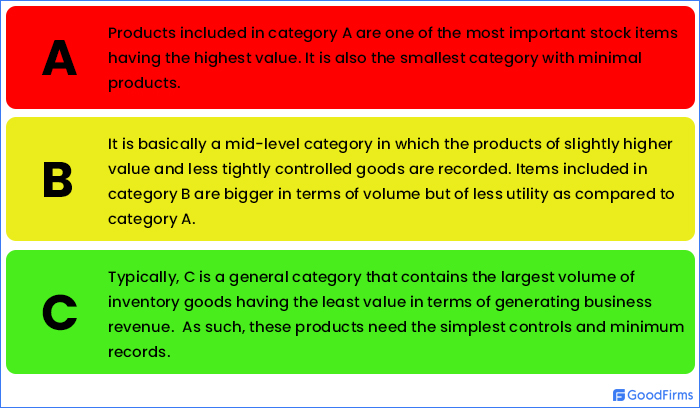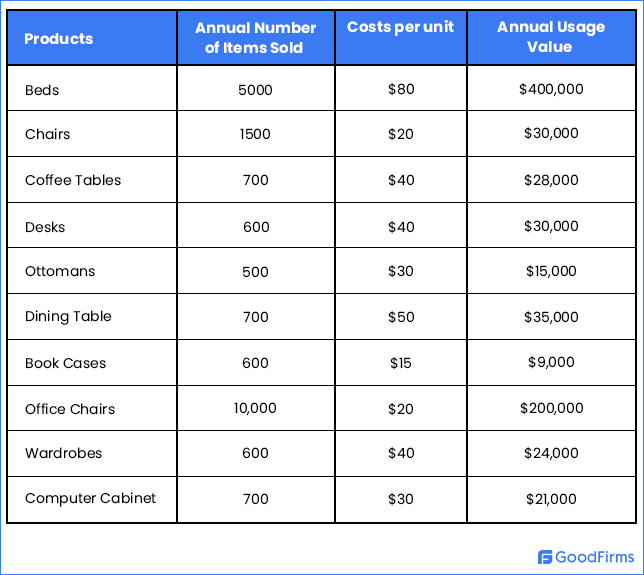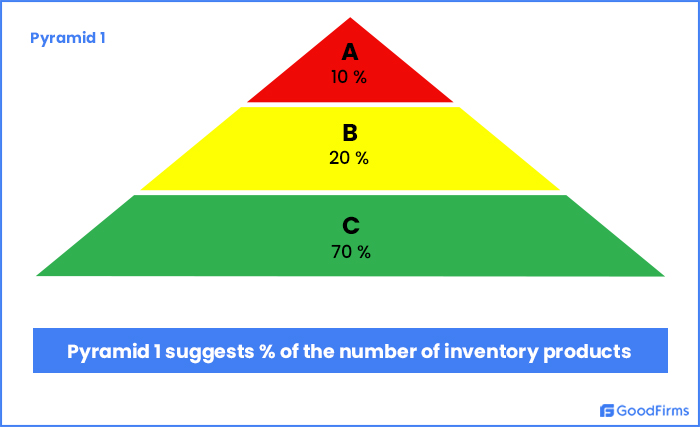Table of Content:
- What is ABC Analysis?
- Category of ABC Analysis
- ABC Analysis Graph
- How to Calculate ABC Analysis?
- Example of ABC Analysis
- The Salient Features of ABC Analysis
- Why is it Critical to Use ABC Analysis for Inventory Management?
- How to Conduct an ABC Analysis?
- Major Applications of ABC Analysis
- Future Trends in ABC Analysis
Most business organizations regard inventory management as one of the most humongous and daunting tasks. But inventory management is crucial for all business domains such as manufacturing, retail, e-commerce, logistics, and many more. It helps entrepreneurs to maintain optimum stock levels and avoid stock out situations.
One of the optimal techniques helping managers to optimize the inventory levels is ABC Analysis.The following article will run through a detailed discussion on its definition, the categories, the calculation methodology, and the benefits.
What is ABC Analysis?
ABC Analysis also referred to as ABC Classification, is an integral part of material management. It is an inventory categorization method, which classifies the inventory primarily into three distinct categories based on the revenue generation. ABC inventoryhelps business entrepreneurs and stock owners identify the essential products in the stock and prioritize their management based on the value. The inventory analysis is based on the Pareto Principle.
The Pareto Principle is a popular economic theory, discovered by renowned Italian economist Vilfredo Pareto. Pareto believed that optimum economic growth occurs only due to a small part of the economy. It means that the relation between the input and output is always unequal.
Pareto Principle states that 80% of the sales volume gets generated from the top 20% of the items. It says that in any group, there are significant few and insignificant many. It is also known as the 80/20 rule.
Category of ABC Analysis
ABC Analysis is based on the theory that all inventory items cannot have similar or equal value. Hence, the three categories include-

If one implements the Pareto Principle to ABC Analysis, then A consists of 20% of the total products with almost 80% revenue generation. Hence, it demands a robust and consistent control. B regulates approximately 30% of the goods with 15% revenue, while C has the lion's share controlling almost 50% of the stock but only powering 5% of the total revenue. Hence the stock managers are quite lenient while calculating this category of inventory.
ABC Analysis Graph
The two pyramids represent the ABC Analysis Graph.
The first pyramid suggests the percentage of the total number of inventory items. Here Category A comprises only 10% of products, B contains 20% items, and C has the maximum number with 70% of products.

Similarly, if one perceives the second pyramid representing the percentage of average inventory value, the structure reverses. Here, A gains the spotlight with almost 70% of inventory value and revenue generation, while B retains its mid-level spot controlling 20% of inventory value. C only generates 10% of revenue; hence it has limited control.
In short, A signifies most important, B indicates moderately necessary, and C denotes least essential inventory goods.
How to Calculate ABC Analysis?
A stock manager can performABC calculations on both individual product groups or a wide range of inventory. An ABC Calculation is usually carried out within five steps, which are as follows-
- First, multiply the annual number of products with each item's cost and find the utility of that product.
- Make a category of every product in the descending order based on its usage value.
- Add the usage value of the products, including the total number of items.
- Find out the cumulative percentages of items sold and annual consumption value.
- Now, it's time to divide your data into three categories, finally, in an approximate ratio of 80:15:5.
Example of ABC Analysis
ABC calculation has been further illustrated through an example containing a few tables.
One can take the example of a Furniture Store.
Step 1: Multiply the total number of items by the cost of each unit to find the annual usage value.

Step 2: After noting all the products of the inventory, it’s time to list them in the descending order based on annual consumption value.

Step 3: Sum up and add the total number of units sold and the annual consumption value.

Step 4: Find out the cumulative percentage of products sold along with the percentage of annual consumption value.

Step 5: In the last step, split the data and numbers into the three A, B, and C categories. Remember, it’s essential to set the data in the ratio of 80:15:5.

The table shows that items listed in Category A generate approximately 79% of annual consumption value, B yields 13%, while C generates 8% revenue.
The Salient Features of ABC Analysis
It’s essential to highlight the pivotal features of all the three categories viz—A, B, and C on a separate note. Have a look at the image below.

Why is it Critical to Use ABC Analysis for Inventory Management?
Many organizations have massive Stock Keeping Units or SKUs, but it hasn't helped them to flourish and upscale their business. Furthermore, there are various other inventory managementchallenges that a business entrepreneur has to tackle. It may include inadequate knowledge about the stock, inefficient management process, finding problems in managing people and space, and more.
Inventory classification is a viable solution that can help enterprises streamline their inventory management process. As the name suggests, inventory categorization is a method to strategically set the price of various products based on their demand value. The ABC method of inventory is a classification technique that helps stock managers resolve all concerns related to maintaining inventory and maximize the inventory value of the goods.
- Analyze the Customer Demand for a Particular Product Category
Every product must pass through four main stages; launch, growth, maturity, and then declination. When a product gains optimum value, it inevitably sinks at a certain point in time. It is known as the lifespan of a product.
It is essential to note that the lifespan of a product depends on the customer demands. It is here that ABC inventory classificationgains the spotlight as it helps business enterprises in precisely analyzing customer demands. The business owners and inventory managers can analyze the consumer needs of a specific product and manage their inventory accordingly. If the market for an item escalates, the downfall period gets pushed further.
- Streamlining and Optimizing the Inventory Process
One of the significant. Unique Selling Points or USPs of ABC Analysis is streamlining and optimizing the inventory management process. It helps inventory managers to organize and segregate stock based on their annual consumption value and revenue generation. The products can also be categorized based on customer demands.
- Conducive Negotiation with the Supplier
ABC Analysis is also useful in getting a conducive negotiation with the supplier. For example, if an enterprise is negotiating with the suppliers of A category products, it has to make a maximum investment there since it offers maximal revenue. Even if the business is making a lucrative offer, there are chances that the supplier is still unwilling to strike the deal.
In such a scenario, the business can still seal the deal by offering other benefits such as lowering the down payment and providing free shipping. It helps to create a favorable win-win situation for both parties. It also allows businesses to save more on A category products and reaping more profits.
- Strategic Pricing of the Products
ABC inventory analysis also allows organizations to set the price of various products strategically. It enhances the inventory value of the products. Once the cost of the products is set strategically, it becomes relatively easier to align them based on different categories. If the demand for the product increases, the seller can hike the price.
- Enhancement in Customer Service Levels
The warehouse managers can stock the products based on their value and importance. It means that they do not need to overstock any such items that are not sold regularly and have a low margin. Here, ABC Analysis can play a pivotal role in helping inventory managers set service levels based on categorizing the items. It further streamlines the supply chain management process.
- The Allocation of the Resources
An inventory manager has to give a special status to A-class items and focus on that specific category. But if he finds that the demand for A category items has reduced and that it is no longer generating higher revenue, the products are demoted to a lower category.
How to Conduct an ABC Analysis?
A business organization can conduct a precise ABC Analysis by ensuring the following steps-
- Find out what needs to analyzed and anticipate the success ratio
When a business conducts an ABC Classification, it has two prime objectives. First, to ensure that supply costs are highly competitive and second to boost the cash flow by storing high demanding products in the stock.
- Gathering Data for Analyzing
If the company uses an inventory management system or accounting software, it can easily collect vital data related to various stock items. Plus, it can also gather information on its annual expenditure, orders and purchases, transportation costs, and more.
- Rank the Inventory in Descending Order
Next, it's essential to classify or organize the inventory in the descending order. Place the maximal-priced product on the top and the minimal-priced item at the bottom. Even during cycle counting - a process where high inventory accuracy can be maintained throughout the year can be done using the ABC method.
- Calculating the Cumulative Impact
Now make a note of all the products and add them in a spreadsheet. It's time to calculate their cumulative effect on the business. The products are divided into two columns; the total number of products sold and their annual costs. Take out the cumulative percentage of annual usage value to categorize the inventory.
- Classify the Inventory Based on the Demand
It is at this stage that one needs to apply the Pareto Principle. It's not necessary to use the 80/20 rule, but it's essential to take a few pivotal measures. The steps include conducive negotiation with the suppliers, framing a product price strategy, ensuring the optimal value of the products, and more.
- Monitor the Categories and Allocate the Products Accordingly
It is the last step where managers have to keenly analyze the categories and then allocate the products based on revenue generation. It means that an item minting the highest money will peak the class. But it contains only a few product sources. On the other hand, the ones providing lower returns will drop down the list. Besides that, the managers need to continuously keep an eye on pricing, customer demand, and product performance.
Major Applications of ABC Analysis
The Manufacturing Sector
ABC Inventory Analysishelps manufacturers to improve the inventory replenishment schedule. It allows managers to categorize stock items based on the total annual cost. Also, ABC Analysis becomes mandatory if the organization plans to integrate the Kaban to manage the workflows.
Supply Chain and Warehouse
The supply chain and warehouses use ABC Inventory Classification mainly for the stock count cycles. For instance, items placed in category A have to be counted quarterly. B class items need a bi-annual counting. On the other hand, C category products get the most liberty. They are calculated on an annual basis, once in a year.
Retail and E-commerce
The retail and the e-commerce industry usually choose ABC Managementfor customer segmentation. It helps retailers and e-commerce owners to pinpoint their most valuable customers. ABC Analysis is performed using key metrics such as sales revenue, buying potential, and contribution margin. The retailers can create a chart based on the metrics and then rank their customers in A, B, and C categories accordingly.
Logistics Industry
The logistics industry is also reaping the benefits of ABC Analysis. Here ABC management plays a pivotal role in controlling the inventory. The products are classified according to their importance based on different criteria such as sales ratio, profit margin, and cost of transportation, etc.
Future Trends in ABC Analysis
The business enterprises today are operating more in a data-driven era powered by digital transformation, Inventory management has already upscaled and potentially escalated; all thanks to the best free and open source inventory management software. But the innovative technologies are also playing a dominant role in modernizing and upgrading the ABC method of inventory.
It is interesting to note that futuristic trends such as Big Data, the Internet of Things, and AI to replenish data. For instance, ABC Inventory System with multiple criteria is using the Artificial Intelligence-based inventory classification process.
Future driving trends will help managers to make a more accurate and complete inventory analysis with data transparency. Furthermore, it will also allow them to save a lot of their valuable time and labor costs.
Also, it is interesting to note that ABC Analysis is no more restricted to inventory management and supply chain business. Even large service sector organizations such as healthcare firms and retail banks have started to use ABC Analysis successfully. It is expected that more industries will join the party within the next few years.
ABC Classification indeed offers a plethora of benefits, but it has a few limitations as well. It consumes much of the valuable time and effort as all inventory items have to be divided into three categories based on its value. Also, the ABC inventory systemis based on the monetary value of the products and ignores all other factors.
One of the best ways to resolve all these issues is to implement an inventory optimization software that can automate and streamline the entire process.
Conclusion
ABC Analysisis one of the best ways business entrepreneurs and inventory managers can classify their stocks based on their value and revenue generation. The ABC method of inventory allows them to focus on essential products and monitor their pricing. It also helps to keep the inventory under control, and businesses can plan their expenditures accordingly.
Also, if you are interested in investing in viable and futuristic inventory management software, then please go through the inventory management software buyer’s guide, where you will find a comprehensive overview of the software, including its vital features and advantages.




